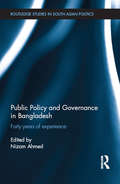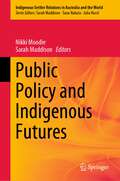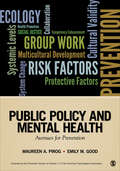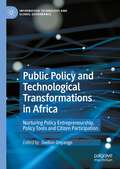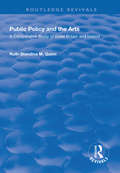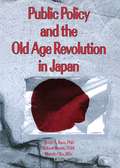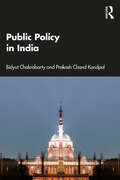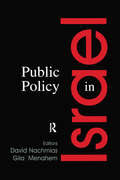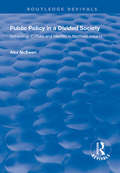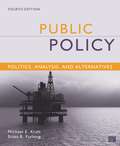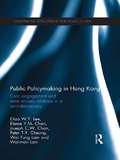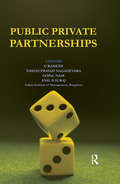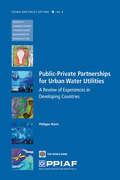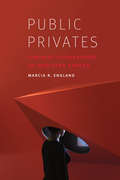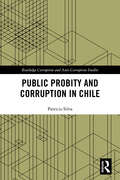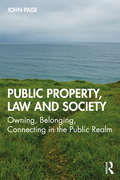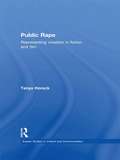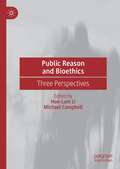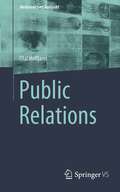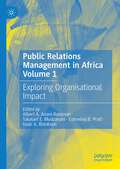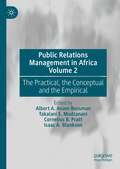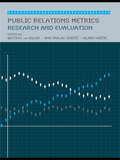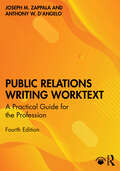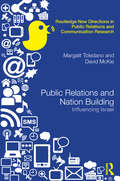- Table View
- List View
Public Policy and Governance in Bangladesh: Forty Years of Experience (Routledge Studies in South Asian Politics)
by Nizam AhmedGood policies are an important prerequisite of good governance, and any effort to change one is likely to affect the other. In emerging democracies, such as Bangladesh, a redefinition of roles and responsibilities of different actors in the policy and governing process can be noticed. This book identifies and analyses issues related to the making and implementation of public policies in Bangladesh over the last four decades (1972-2012). It explores the implications of the change that has taken place in policy and governance environment in Bangladesh. Focusing on several important sectoral and sub-sectoral polices, it examines the impact and limitations of the change. Chapters are structured into four parts: Public Policy, Bureaucracy and Parliament; Cases of Public Policy; Women in Governance and Public Administration; Ethics, Innovations, and Public Service Delivery, and the book is a valuable resource for researchers in the field of development studies, public policy and South Asian politics.
Public Policy and Governance in Bangladesh: Forty Years of Experience (Routledge Studies in South Asian Politics)
by Nizam AhmedGood policies are an important prerequisite of good governance, and any effort to change one is likely to affect the other. In emerging democracies, such as Bangladesh, a redefinition of roles and responsibilities of different actors in the policy and governing process can be noticed. This book identifies and analyses issues related to the making and implementation of public policies in Bangladesh over the last four decades (1972-2012). It explores the implications of the change that has taken place in policy and governance environment in Bangladesh. Focusing on several important sectoral and sub-sectoral polices, it examines the impact and limitations of the change. Chapters are structured into four parts: Public Policy, Bureaucracy and Parliament; Cases of Public Policy; Women in Governance and Public Administration; Ethics, Innovations, and Public Service Delivery, and the book is a valuable resource for researchers in the field of development studies, public policy and South Asian politics.
Public Policy and Indigenous Futures (Indigenous-Settler Relations in Australia and the World #4)
by Sarah Maddison Nikki MoodieThis book focuses on Indigenous self-determined and community-owned responses to complex socioeconomic and political challenges in Australia, and explores Indigenous policy development and policy expertise. It critically considers current practices and issues central to policy change and Indigenous futures. The book foregrounds the resurgence that is taking place in Indigenous governing and policy-making, providing case studies of local and community-based policy development and implementation. The chapters highlight new Australian work on what is an international phenomenon.This book brings together senior and early career political scientists and policy scholars, and Indigenous and non-Indigenous scholars working on problems of Indigenous policy and governance.
Public Policy and Mental Health: Avenues for Prevention (Prevention Practice Kit)
by Pirog Maureen A. and Good Emily M.This eighth book in the Prevention Practice Kit provides a broad overview of the types of policies governments establish to prevent mental disorders as well as the various ways in which these policies are created. The authors describe the process of analyzing public programs, laws, policies, and managerial innovations in mental disorder prevention, and help readers examine both the rationale for these programs and policies and whether or not they really work.The text includes valuable case studies on the development of prevention interventions, the impact of individuals and organizations on policies, what happens when attempts to change policies are ineffective, and the considerable amount of effort that is often needed to create needed policy changes in the mental health arena. Questions are provided throughout the text to encourage the reader to engage the topics in a critical manner.This book is part of the Prevention Practice Kit: Action Guides for Mental Health, a collection of eight books each authored by scholars in the specific field of prevention and edited by Dr. Robert K. Conyne and Dr. Arthur M. Horne. The books in the collection conform to the editors′ outline to promote a consistent reading experience. Designed to provide human services practitioners, counselors, psychologists, social workers, instructors, and students with concrete direction for spreading and improving the practice of prevention, the series provides thorough coverage of prevention application including a general overview of prevention, best practices, diversity and cultural relevance, psychoeducational groups, consultation, program development and evaluation, evidence base, and public policy.This book is endorsed by the Prevention Section of the Society of Counseling Psychology of the American Psychological Association. Fifty percent of all royalties are donated to Division 17 of the APA.
Public Policy and Technological Transformations in Africa: Nurturing Policy Entrepreneurship, Policy Tools and Citizen Participation (Information Technology and Global Governance)
by Gedion OnyangoThis book examines the links between public policy and Fourth Industrial Revolution (4IR) technological developments in Africa. It broadly assesses three key areas – policy entrepreneurship, policy tools and citizen participation – in order to better understand the interfaces between public policy and technological transformations in African countries. The book presents incisive case studies on topics including AI policies, mobile money, e-budgeting, digital economy, digital agriculture and digital ethical dilemmas in order to illuminate technological proliferation in African policy systems. Its analysis considers the broader contexts of African state politics and governance. It will appeal to students, instructors, researchers and practitioners interested in governance and digital transformations in developing countries.
Public Policy and the Arts: A Comparative Study of Great Britain and Ireland (Routledge Revivals)
by Ruth-Blandina M. QuinnFirst published in 1998, this volume considers the subject of arts policy as a subject of public policy making proper in UK and Ireland, with a particular focus on theatre as a profession rather than a mere hobby. Previous studies have placed the burden of policy improvements on the arts themselves, looking at what ‘the arts’ can do to be worthy of government funding and favourable policy, and have seen government actions as if they have a uniform effect. This study takes ‘the arts’ out of the abstract and discusses specific ways that diverse activities with even more diverse needs can be best approached with government policy, assessing the strengths and weaknesses of government initiatives. It is aimed at both political scientists and anyone with an interest in arts and cultural policy.
Public Policy and the Old Age Revolution in Japan
by Robert Morris *Deceased* Scott Bass Masato Oka Jill NortonThirty years ago, when compared to the U.S., England, France, and Sweden, Japan had the lowest life expectancy for males and females. Today, Japan has the highest life expectancy and is the world’s most rapidly aging society. Public Policy and the Old Age Revolution in Japan captures the vitality of Japanese policymakers and the challenges they face in shaping a modern society responding to its changing needs. The rapid transition to an aging society poses a set of complex policy and resource dilemmas; the responses taken in Japan are of great value to policymakers, professionals, and students in the fields of gerontology, Asian and Japanese studies, sociology, public policy, administration and management, and anthropology in other industrial aging societies. Readers of Public Policy and the Old Age Revolution in Japan will discover the array of social and economic implications that comes with an increasingly aged society. Such a change in demographics affects pension expenditures and pension contributions, capital formation and savings rates, health costs, service systems, tax bases, labor pools, career counseling, training, advertising, and marketing. This book does not stop with these topics, however. Readers also learn about: how older Japanese workers are staying employed and employable policies in Japan for a smooth transition from work to retirement Japan’s Silver Human Resource Centers the new direction of health services in Japan the Japanese financing system for elderly health care the expansion of formalized in-home services for Japan’s aged Japanese housing policy and the concept of universal design the Gold Plan, a comprehensive ten-year plan to promote health care and welfare for the aged the concept of ikigai--promoting feelings of purpose and self-worth in the agedPublic Policy and the Old Age Revolution in Japan is one of only a handful of books prepared in English by American and Japanese authors for an international audience about aging and social policy in Japan. The book’s recent collection of articles by leading scholars on the subject makes it a unique and timely source of information. Above all, Public Policy and the Old Age Revolution in Japan makes it clear that the rest of the world has many valuable lessons to learn by studying Japan’s approach to its rapidly aging society.
Public Policy in India
by Bidyut Chakrabarty Prakash Chand KandpalThis textbook is a comprehensive, student-friendly guide to public policy in India. It highlights the critical aspects of public policy-making and its implementation by contextualizing it in the Indian historical and modern-day perspective. Public Policy in India: • Provides lucid explanations of theoretical aspects of public policy and its practice in the Indian context; • Captures the complexities in making, implementing and evaluating public policy; • Studies the dialectical interconnection that public policy has with the socio-economic and political environment; • Highlights the influence of culture on public policy; and • Analyses public policy as an outcome of a very complex contextual dialogue involving various kinds of actors. Accessibly written, this book covers a range of university syllabi and will be essential reading for students and researchers of political science and public administration. It will also be indispensable for civil service examinations, including the UPSC.
Public Policy in Israel (Israeli History, Politics and Society #Vol. 17)
by David Nachmias Gila MenahemAn examination of the current Israeli government, covering public policies such as health, housing and transport. The volume covers the institutional as well as the political and the bureaucratic framework within which public policies have been made and implemented.
Public Policy in a Divided Society: Schooling, Culture and Identity in Northern Ireland (Routledge Revivals)
by Alex McEwenFirst published in 1999, this volume is focused on the framing and implementation of public policy in education in a society with deeply entrenched cultural and political identities as expressed by Protestants and Catholics through their different schooling systems.
Public Policy: Politics, Analysis, And Alternatives, 4th Edition
by Michael E. Kraft Scott R. FurlongAll too often, public policy textbooks offer a basic grounding in the policy process without the benefit of integrating the use of policy analysis. Kraft and Furlong, since their first edition, take a different tack. They want students to understand how and why policy analysis is used to assess policy alternatives-not only to question the assumptions of policy analysts, but to recognize how analysis is used in support of political arguments. To encourage critical and creative thinking on issues ranging from the financial bailout to rising gas prices to natural disasters, the authors introduce and fully integrate an evaluative approach to policy. Public Policy starts with a concise review of institutions, policy actors, and major theoretical models. The authors then discuss the nature of policy analysis and its practice, and show students how to employ evaluative criteria in six substantive policy areas. Public Policy arms students with analytic tools they need to understand the motivations of policy actors-both within and outside of government-influence a complex, yet comprehensible, policy agenda. Enhancements to the 4th edition: - All chapters have been comprehensively updated to include recent events, issues, and policy debates including the conduct of the wars in Afghanistan and Iraq, the use of private contractors for military support and operations, the rising cost of gasoline and disputes over energy policy and climate change, the controversy over immigration policy, requirements for financial regulation, heightened concerns over economic and social inequality, and the clash over reforming taxes and entitlement programs, as well as dealing with the federal deficit and national debt. - New and updated working with sources and steps to analysis features help students investigate sources of information and apply evaluative criteria. - New and updated end-of chapter discussion questions, suggested readings, and web sites.
Public Policymaking in Hong Kong: Civic Engagement and State-Society Relations in a Semi-Democracy (Comparative Development and Policy in Asia)
by Eliza W.Y. Lee Elaine Y.M. Chan Joseph C.W. Chan Peter T.Y. Cheung Wai Fung Lam Wai Man LamWhy and how has civic engagement emerged in the policy process of Hong Kong as an Asian semi-democratic state? This book attempts to answer this question through examining six cases that straddle diverse policy domains. It identifies three explanatory factors, namely, the profile of a policy domain, the structure of societal interest, and the strength of the civil society sector as important in shaping the state’s strategy in managing society, hence its propensity to engage. These factors affect the outcome through dynamic interaction between the state and societal actors. The findings outlined in the book show that the development of civic engagement in Hong Kong consists of both society-led and state-led cases. Society-led development brought about a high degree of openness and inclusiveness, whereas state-led civic engagement practices tended to be tactics utilized by the state for appeasing or depoliticizing civil society. Compared with other Asian regimes, the use of ‘transgressive contention’ as a way to compel the state to engage society is a feature that stands out in the liberal autocratic regime in Hong Kong.
Public Private Partnerships
by Vishnuprasad Nagadevara Gopal Naik G. Ramesh Anil B. SurajThe collection of papers brings out the complexities in PPP in terms of types, conceptualization, structure, institutions, and financing. It covers a broad sweep ranging from infrastructure to services and utilities; and from global to Indian states. The methodology is primarily empirical but the thrust is on conceptualization of PPP in its various forms and frameworks. PPP is still a practitioner’s field but is growing in size and significance; and as a solution to failures of public system and the consequent privatization. It is a major attraction to policy makers and funding agencies given its middle-of-the-road approach. It is likely to gain currency, but it is important that we get deeper understandings of this form before we place more faith in this. The papers in this book, selected from a conference on PPP held at the Indian Institute of Management Bangalore in 2008, raise several important conceptual issues and seek to address some of them.
Public Private Partnerships for Urban Water Utilities: A Review of Experiences in Developing Countries
by Philippe Marin'Public-Private Partnerships for Urban Water Utilities: A Review of Experiences in Developing Countries' analyzes the market growth of Public-Private Partnerships (PPPs) in the developing world since 1990, and the performance of more than 65 large water PPP projects-representing more than 100 million people-for access, service quality, operational efficiency, and tariff levels. Although a relatively small portion of the water utilities in the developing world are operated under PPPs (about 7 percent in 2007), the urban population served by private water operators has grown every year since 1990. Despite many difficulties encountered by PPP projects and a few contract terminations, a large majority of contracts awarded since 1990 are still in place. The track record for improving service and efficiency reaffirms the value of PPPs to help turn around poorly performing water utilities, even though the level of private financing did not match initial expectations. Over time, a more realistic market has developed, the number of private investors from developing countries has grown, and contract designs have become more pragmatic concerning risk allocations between partners. The water sector has many features that set it apart from other infrastructure sectors. This book suggests the need for careful consideration of those specificities to successfully involve private operators. Although concessions with private financing have worked in a few places, contractual arrangements that combine private operation with public financing appear to be the most sustainable option in many countries. Policy makers, stakeholders, and donors need to remain heavily engaged in the water sector, especially in the poorest countries and during a global financial crisis. This book contributes to a better understanding of the various options to tackle the many challenges of providing water and sanitation services to urban populations in the developing world.
Public Privates: Feminist Geographies of Mediated Spaces
by Marcia R. EnglandPublic Privates focuses on public and private acts and spaces in media to explore the formation of geographies. Situated at the intersections of cultural geography, feminist geography, and media studies, Marcia R. England’s study argues that media both reinforce and subvert traditional notions of public and private spaces through depiction of behaviors and actions within those spheres. Though popular media contribute to the erosion of indistinct edges between spaces, they also frequently reinforce the traditional dualism through particular codings that designate the normed and gendered socio-spatial actions appropriate in each sphere—producing geographical imaginations and behaviors. England applies her immensely readable construction to a diverse and wide-ranging array of media including Buffy the Vampire Slayer, The Fast and the Furious, J-Horror, sitcoms, Degrassi, and reality TV. By examining the gendered representations of public and private spaces in media and how images influence imagined and lived geographies, England shows how popular culture, specifically visual media, transmits ideologies that disintegrate the already blurred boundaries between public and private spaces.
Public Probity and Corruption in Chile (Routledge Corruption and Anti-Corruption Studies)
by Patricio SilvaIn most Latin American countries, key officials and political figures have been involved in big corruption scandals in the last decade, leading to a rigorous academic debate on the possible socio-economic, political and cultural factors responsible for corrupt practices across the region. This book takes a different approach by focusing on Chile, which shows the lowest levels of corruption in the region. Instead of analysing notoriously bad cases in Mexico, Argentina, Brazil and Venezuela, this book explores the factors which have led to a relatively high degree of public probity among power holders in Chile. Public Probity and Corruption in Chile presents a long-term historical analysis demonstrating that public probity in Chile has its roots in the colonial period, and that public and state responses have historically shown a low level of tolerance for public cases of corruption. In particular, the author highlights the role played by relative poverty and lack of resources, geographical remoteness, the impact of the Arauco War against the Mapuche people, the militarisation of both government and public administration, the extreme oligarchic nature of the Chilean aristocracy, the early consolidation of state institutions and the rule of law, high levels of political stability and the role played by patriotism. Studying an example of better practice in detail in this way provides valuable insights into the factors and actors which can help to prevent or to revert the phenomenon of public corruption in the region more generally. As such, this book will be of interest to researchers of corruption and public probity both in Chile and further afield.
Public Property, Law and Society: Owning, Belonging, Connecting in the Public Realm
by John PageThis book examines the almost entirely neglected realm of public property, identifying and describing a number of key organizing principles around which a nascent jurisprudence of public property may be developed. In property law terms, the public realm is lost to plain view. Despite the vast acreage of public lands, or the extensive tracts of private lands over which public rights subsist, there is little commensurate scholarly discussion of the ideas, theories, practices, and laws of public property. This is no accident. Public property has been marginalized and pushed to the periphery for centuries, a consequence of the dominant discourse of private property, and its enclosing, encroaching tendencies. This book explores the rich diversity of the public estate, of what the public realm means for us, the general public, canvassing what we may ‘own’, where we may ‘belong’, or not, and how we may ‘connect’ through a shared use and enjoyment of public place and space. To better understand public property is to better value its critical public-wealth. Whether overlooked, over-used, or under threat of imminent loss, this book maintains that our loved (and not so loved) public spaces are essential components of our diverse, functioning, and optimistically livable human geographies. As such, they demand legal protection. This important and original book will be of considerable interest to scholars and others with interests in property and land law, socio-legal studies, legal geography and urban studies.
Public Rape: Representing Violation in Fiction and Film
by Tanya HoreckSecond-wave feminism fought to end the blanket silence shrouding rape and bring it to public attention. Now feminist critics must confront a different issue. In Public Rape Tanya Horeck considers the public investment in images of rape and the figure of the raped woman. Introducing the idea of 'public rape', Horeck looks at how images of rape serve as cultural fantasies of sexual, racial and class difference. Looking at rape in real life as well as in literature and films such as The Accused and Boys Don't Cry, Horek reveals how representations of rape raise vital questions about the relationship between reality and fantasy, and between violence and spectacle
Public Reason and Bioethics: Three Perspectives
by Michael Campbell Hon-Lam LiThis book explores and elaborates three theories of public reason, drawn from Rawlsian political liberalism, natural law theory, and Confucianism. Drawing together academics from these separate approaches, the volume explores how the three theories critique each other, as well as how each one brings its theoretical arsenal to bear on the urgent contemporary debate of medical assistance in dying. The volume is structured in two parts: an exploration of the three traditions, followed by an in-depth overview of the conceptual and historical background. In Part I, the three comprehensive opening chapters are supplemented by six dynamic chapters in dialogue with each other, each author responding to the other two traditions, and subsequently reflecting on the possible deficiencies of their own theories. The chapters in Part II cover a broad range of subjects, from an overview of the history of bioethics to the nature of autonomy and its status as a moral and political value. In its entirety, the volume provides a vibrant and exemplary collaborative resource to scholars interested in the role of public reason and its relevance in bioethical debate.
Public Relations (Medienwissen kompakt)
by Olaf HoffjannWährend Werber mit ästhetischen Spots und humorvollen Anzeigen das Publikum unterhalten, bleiben PR-PraktikerInnen im Halbdunkel der Hinterbühne. In dem Band soll diese Hinterbühne ausgeleuchtet werden. Zunächst wird erklärt, was man genau unter Public Relations verstehen kann und was sie von der Werbung unterscheidet. Pressesprecher zielen mit ihren vielfältigen Angeboten auf JournalistInnen und versuchen so, die Berichterstattung zu beeinflussen. Während manche davon ausgehen, dass sie einen Großteil der Berichterstattung kontrollieren, sehen andere eine größere Macht bei den Journalisten. Mit ihren wünschenswerten Wirklichkeiten versucht die PR, schöne und vor allem tadellose Fassaden zu errichten, die nicht immer etwas mit dem unternehmerischen Handeln hinter dieser Fassade zu tun haben müssen. Viele PR-Skandale der vergangenen Jahre zeigen, wie PR versucht hat, Verfehlungen oder Störfälle zu verharmlosen oder gar zu verheimlichen. Die Digitalisierung ermöglicht der PR ganz neue Möglichkeiten: Video-Kanäle, soziale Netzwerke und digitale Influencer sind neue Wege, die Zielgruppen zu erreichen. Und nicht selten führt dies dazu, dass etablierte JournalistInnen an den Rand gedrängt werden.
Public Relations Management in Africa Volume 1: Exploring Organisational Impact
by Cornelius B. Pratt Albert A. Anani-Bossman Takalani E. Mudzanani Isaac A. BlanksonThis two-part volume examines current pedagogical modules, research directions and other emerging issues in public relations and communication management in Africa. In comparison to its Western and Asian counterparts, the literature on public relations management in Africa is limited, and much of it is examined through the lenses of Western philosophies and pedagogies that do not generally resonate with Africa's socioeconomic, political, and cultural contexts. This book aims to change that. Through analyzing the organizational dynamic, Volume 1 brings together contributors from across Africa to provide valuable insights into how public relations contributes to organizational effectiveness on the continent. Chapters discussed include a review of public relations research in Africa, the role of the African CEO as a public relations activist, the use of social and digital media in public relations, the measurement and evaluation of communication programs, and the implications of the fourth industrial revolution on public relations practice in Africa. Providing important pathways and overviews of public relations management in Africa, this volume not only highlights current practices but offers insights into the future of the practice within its evolving global landscape.
Public Relations Management in Africa Volume 2: The Practical, the Conceptual and the Empirical
by Cornelius B. Pratt Albert A. Anani-Bossman Takalani E. Mudzanani Isaac A. BlanksonThis two-part volume, the first of its kind, examines current pedagogical modules and research directions in public relations and communication management, identifying emerging issues driving the practice in Africa. In comparison to its Western and Asian counterparts, literature on public relations management in Africa is limited, and much of it is examined through the lenses of Western philosophies and pedagogies, failing to reflect Africa's socioeconomic, political, and cultural contexts. This project aims to change that. Albert Volume 2 brings together African scholars, moving beyond organizational impact to share the wider theoretical and practical perspectives on the practice of public relations on the continent, within its cultural, global, and technological milieu.Through conceptual discussions and empirical analyses, this volume shows how Africa is gradually coming out of the shadows of the Western world by building a body of knowledge the reflects the nature of public relations management on the continent. Chapters cover: how public relations contributes to strategic management in Africa; health communication and public relations management; strategic management of issues, as well as the implications of the fourth industrial revolution for public relations practice in Africa.
Public Relations Metrics: Research and Evaluation (Routledge Communication Series)
by Dejan Verčič Betteke Van Ruler Ana Tkalac VerčičResponding to the increasing need in academia and the public relations profession, this volume presents the current state of knowledge in public relations measurement and evaluation. The book brings together ideas and methods that can be used throughout the world, and scholars and practitioners from the United States, Europe, Asia, and Africa are represented.
Public Relations Writing Worktext: A Practical Guide for the Profession
by Joseph M. Zappala Anthony W. D’AngeloWith a concise approach that engages students and practitioners, this thoroughly updated fourth edition provides the fundamental knowledge and basic skill preparation required for the professional practice of public relations writing.Building on the strengths of previous editions, this edition focuses more closely on PR writing as a strategic function and on planning and content strategy design. With practical advice from PR professionals, it covers everything from day-to-day business communications and media tools to writing for social media and crisis situations.This fourth edition incorporates a number of changes and updates, including: New chapters on Social Media and Writing for Key Publics and new content on the use of generative AI and its impact on PR writing. Expanded chapters on Writing for Digital Communications and on Publications, Presentations, and Speeches. New guest columns from PR professionals on topics including writing and pitching the media, inclusive writing, speech writing. and measuring writing/content impact. New cases and assignments based on topics, issues, and problems that public relations professionals face today. The text is suitable for undergraduate and graduate students in a public relations writing course preparing for entry-level public relations and communications roles, as well as a useful reference for early-career practitioners.Online resources also accompany the book: teaching materials, test banks, and reference sources. Please visit www.routledge.com/9780367860028.
Public Relations and Nation Building: Influencing Israel (Routledge New Directions in PR & Communication Research)
by David McKie Margalit ToledanoAll public relations emerges from particular environments, but the specific conditions of Israel offer an exceptional study of the accelerators and inhibitors of professional development in the history of a nation. Documenting and analyzing the contribution of one profession to building one specific nation, this book tells the previously-untold story of Israeli public relations practitioners. It illustrates their often-unseen, often-unacknowledged and often-strategic shaping of the events, narratives and symbols of Israel over time and their promotion of Israel to the world. It links the profession’s genesis – including the role of the Diaspora and early Zionist activists – to today’s private and public sector professionals by identifying their roots in Israel’s cultural, economic, media, political, and social systems. It reveals how professional communicators and leaders nurtured and valued collectivism, high consensus, solidarity, and unity over democracy and free speech. It investigates such key underpinning concepts as Hasbara and criticizes non-democratic and sometimes unethical propaganda practices. It highlights unprecedented fundraising and lobbying campaigns that forged Israeli identity internally and internationally. In situating Israeli ideas on democracy in the context of contemporary public relations theory, Public Relations and Nation Building seeks to point ways forward for that theory, for Israel and for the public relations of many other nations.
